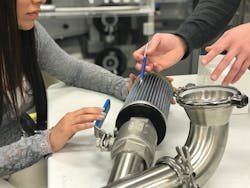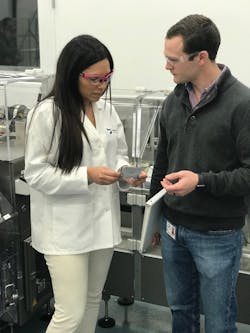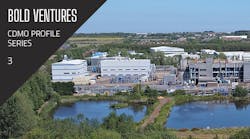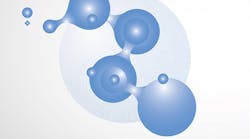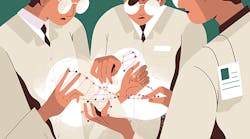Long before the industrial revolution, “technology transfer” already played a significant role in shaping humankind’s fate. The fundamentals of technology transfer were birthed in early human necessities for survival in harsh elements and adaptation to the ever-changing environment. From the earliest stages in civilization, knowledge and wisdom have been passed on through generations — such as the formation of language or the ability to make and maintain fire — and propelled humans to thrive. Reaping the benefits of technological advancements relies heavily on the ability to transfer valuable information and build upon it, thereby standing on the shoulders of predecessors and contemporaries.
Fast forward to 2019, technology transfer, also known as transfer of technology (TOT) is a vital aspect of manufacturing in a variety of sectors, including pharmaceuticals. TOT in the modern era is a critical requirement in taking a pharma product from prototype to commercial launch. Manufacturing typically cannot commence unless a well-planned technology transfer process has been mapped out and vetted by a spectrum of stakeholders.
Getting it Right
Despite technological advancements at our fingertips, TOT is not always perfect. Industry veterans are quick to raise an eyebrow when hearing of a company’s 100 percent success rate in technology transfer. Even with all the process and equipment validations involved, and high levels of automation in place, in modern manufacturing things can and will go sideways. Despite having the most skilled, well-trained individuals manning the manufacturing floor, human error remains a factor. And even with the full automation of validated equipment, over time that equipment and its settings can drift out of parameters, inducing out-of-spec variances.
The main challenges to the timely completion of a technology transfer project are the following:
- Resource constraints
- Raw material availability
- Equipment availability
- Technical issues
- Communication
- Scope creep
Rather than dive into the details of each category above, it’s more important to stress the enormity of several critical ingredients. The concept behind each is simple: In technology transfer, communication is everything.
Successfully translating customer requirements into meaningful product specifications accompanied by actionable work packages is a direct result of excellent communication with proper and appropriate documentation. Open and transparent communication channels must be created at the onset of each project to facilitate the flow of essential information between the client, CMO (contract manufacturing organization), and project team members. Alignment between what is achieved in the laboratory during upstream development to what is achieved at downstream scale-up depends heavily on the integrity and quality of the information that’s provided and passed on to each successive stakeholder.
It is also important to point out that this can only be achieved in an effective and robust system. Even with all the technology available at our disposal, it’s still imperative to have “face-to-face” interaction between clients and scientists because, no matter how well you think you have written a document, there’s always something that can be misinterpreted, misconstrued or simply overlooked.
More than “Just a Vendor”
The CMO-client relationship is an aspect of technology transfer that is often downplayed. Technology transfer is more successful if CMOs are treated by their clients as partners as opposed to “just a vendor” — and vice-versa. The higher the transparency between CMOs and their clients, the more efficient and productive team discussions are. Risks are identified and mitigated, and issues get resolved a lot faster when project team members from both the client and CMO trust each other — ultimately minimizing costly timeline impacts.
This may have been said so many times, but the more we know about the process, the better we can be in addressing issues later on. One can never overemphasize the need for careful and proper planning to fully understand product requirements and project scope, and providing development teams enough time to understand and game plan the testing and manufacturing processes.
New products and new technologies to a CMO, no matter how simple or straightforward they appear, will always challenge the status quo because one must demonstrate and incorporate repeatability and reproducibility. It may be very unappealing to project sponsors who are always conscious about the completion date and budget, but in the end, it’s always a lot cheaper to invest and dispose of a few small-scale trial lots than to encounter a significant design change mid-execution or, even worse, face a costly product recall that can potentially result in lawsuits.
An unidentified gap in the critical path, no matter how small, can unfavorably impact outcomes by inducing domino ripple-effects upon limited resources. Leaders must be prepared to guide all parties through the “forming and storming” process, because team members from differing professional backgrounds will tend to focus on disparate, often minute details that prevent the group from transitioning to the desired “norming and performing” stages of project execution.
An engineer discusses tooling and component specifications with a machinist to create a prototype tool in the shop.
The Balancing Act
Often, process development goes hand-in-hand with analytical method development. Having established analytical methods is one of a CMO’s cornerstones in technology transfer, as it determines and limits what the organization can do. Analytical methods are required for:
- Identification of process suitability and consistency (blend uniformity, filling consistency, etc.)
- In-process product testing and release
- Characterization for raw materials and products
- Cleaning methods, such as making sure equipment and facility are free of residue or products that can affect the current or future product integrity (i.e., total organic carbon for proteins)
Tied into the challenges of process and analytical development is the balancing act one must perform to ensure timely raw material availability throughout the project life cycle. A seasoned project manager will know to incorporate in the plan (budget and timeline) the need for additional raw materials, because development will consume a lot of materials. Unforeseen technical issues can often deplete material contingencies that result in an undesirable halt in development work or production — a meddlesome pause that can quickly become a timeline pressure point.
Lead times and minimum order quantities for all raw materials also must be considered during planning to avoid, for example, costly delays due to unutilized resources when activities come to a halt. In certain instances fees should be expedited to mitigate long lead times, a factor that comes into play especially on shared, multi-use production lines.
It’s an imperfect process out of which perfection is expected. But the reality is, there will be little to no extra money laying around to spend on full-scale development work. The team, guided by a risk assessment, must determine the minimum number of runs or amount of data that can be collected to move the project forward. Often, three small-scale batches are sufficient to generate enough data to satisfy statistical requirements.
Translation of product requirements, starting with project managers and continuing through the project workforce, is a direct product of effective communication.
Defining Success
What does success look like? What should every team working in technology transfer projects strive for as the end state of the project? At the onset of every technology transfer project, the project team(s) should prepare the following objectives to increase the rate of success:
- Quantification of the product needs, and a process to translate that to appropriate specs
- Understanding of your process and how to make it robust to ensure a high transfer success rate
- Knowledge of your team and how to communicate throughout the project life cycle effectively
One might expect that, given our many years of practice time, humankind would have perfected technology transfer by 2019, that it would be an exact science with standardized tools, repeatable processes, and guaranteed success rates. Due to human individuality and product differentiation, coupled with unique process environments, a “one-size fits all” prescription to technology transfer remains elusive.
Project leaders must draw inspiration from their team members’ individualities and capitalize and harness strengths to overcome concurrent weaknesses. The ability to navigate a multi-functional team as one single organism is key to achieving success because, ultimately, everyone must collectively move toward the shared goal: producing a quality commercial product in spec and on time.

